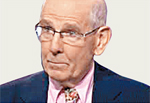Growth pessimists have it wrong

A. Gary Shilling
Yes, huge federal government deficits and debt are a major drag. It’s also that true budget surpluses aren’t likely to materialize, even if growth resumes.
Nevertheless, there is a strong possibility that government debt relative to gross domestic product will fall appreciably, as it did after World War II. Back then, deficits were relatively small, so GDP outran gross federal debt. The debt-to-GDP ratio dropped from 122 percent in 1946 to 43 percent 20 years later.
A more recent example of a reduction of the federal debt-to-GDP ratio came in the 1990s under President Bill Clinton. Robust nominal growth of 5.5 percent a year caused deficits to shrink so much that small surpluses existed in fiscal years 1998 to 2001. Federal tax receipts rose 7 percent on average, faster than nominal GDP, and outlays grew at 3.6 percent. The dot-com bubble lifted individual income-tax receipts at an 8 percent annual rate and corporate taxes by 8.3 percent.
On the outlay side, national defense spending fell 0.2 percent a year as the Cold War ended. Medicare spending jumped 7.2 percent annually, but was only 7.8 percent of outlays in the 1990s. Social Security spending climbed 5.1 percent a year, less than social-insurance receipts.
In contrast, in 2000-12, nominal GDP growth slowed to 3.9 percent while anti-recessionary tax cuts and rebates shrank federal receipts’ annual growth to 1.6 percent. Outlays climbed an average 5.8 percent annually, driven by Iraq and Afghanistan spending and Medicare. Resulting huge deficits drove gross federal debt-to-GDP to 103 percent in fiscal 2012.
The message is clear: Rapid economic growth pushes down the federal debt-to-GDP ratio and indirectly affects government debt, too, as taxpayers get pushed into higher brackets, corporate profits grow faster than the economy, and tax cuts and government spending on social-welfare programs are curtailed.
Conversely, slow economic growth, as in the 2000-12 period, pushes up the ratio directly. It climbs even more as the weak economy spawns tax cuts and counter-cyclical outlays.
So the resumption of rapid economic growth is the answer to the federal debt problem. Of course, the 800-pound gorilla in the room is the need for greater Social Security and Medicare outlays. So far, Congress and the Obama administration prefer gridlock to solving the looming entitlement-spending explosion. The more time that passes, the more disruptive the solution must be. I believe, however, Washington will do what is necessary when there is no other choice.
As for the Reinhart-Rogoff argument - that high government debt depresses GDP - my view is government debt doesn’t depress economic growth, but the other way around. Slow growth depresses tax revenue and raises social spending, causing deficits and debt levels to rise.
I believe much of today’s new technology - the Internet, biotechnology, semiconductors, wireless devices, robotics and 3-D printers - is in its infancy. Collectively, it has the potential to rival the rapid growth and productivity-generating effect of the American industrial revolution and railroads in the late 1800s. Today, only a third of the world’s population is connected to the Internet, but 90 percent live within range of a cellular network.
Sure, productivity grew by only 1.5 percent from 2009-12, but that’s normal after a severe recession. I expect it to return to a 2.5 percent annual growth rate - or more.
Rapid productivity growth offsets slower labor force advances. The decline in the labor-force participation rate is likely to slow once normal economic growth resumes. The rate has fallen as baby boomers retire and discouraged workers drop out of the labor market or stay in college.
In this environment, middle-tier schools will need to be more focused on providing students with careers.
Community colleges with ties to apprenticeship programs that prepare students to be skilled mechanics or operators of sophisticated equipment will also be in demand.
Once private-sector deleveraging is completed, real GDP growth will probably return to its long-run trend of about 3.5 percent, and perhaps more. Productivity improvements and labor-force growth will likely resume. And the slow-growth-forever crowd will need a new theory.
By A. Gary Shilling










with the Korea JoongAng Daily
To write comments, please log in to one of the accounts.
Standards Board Policy (0/250자)